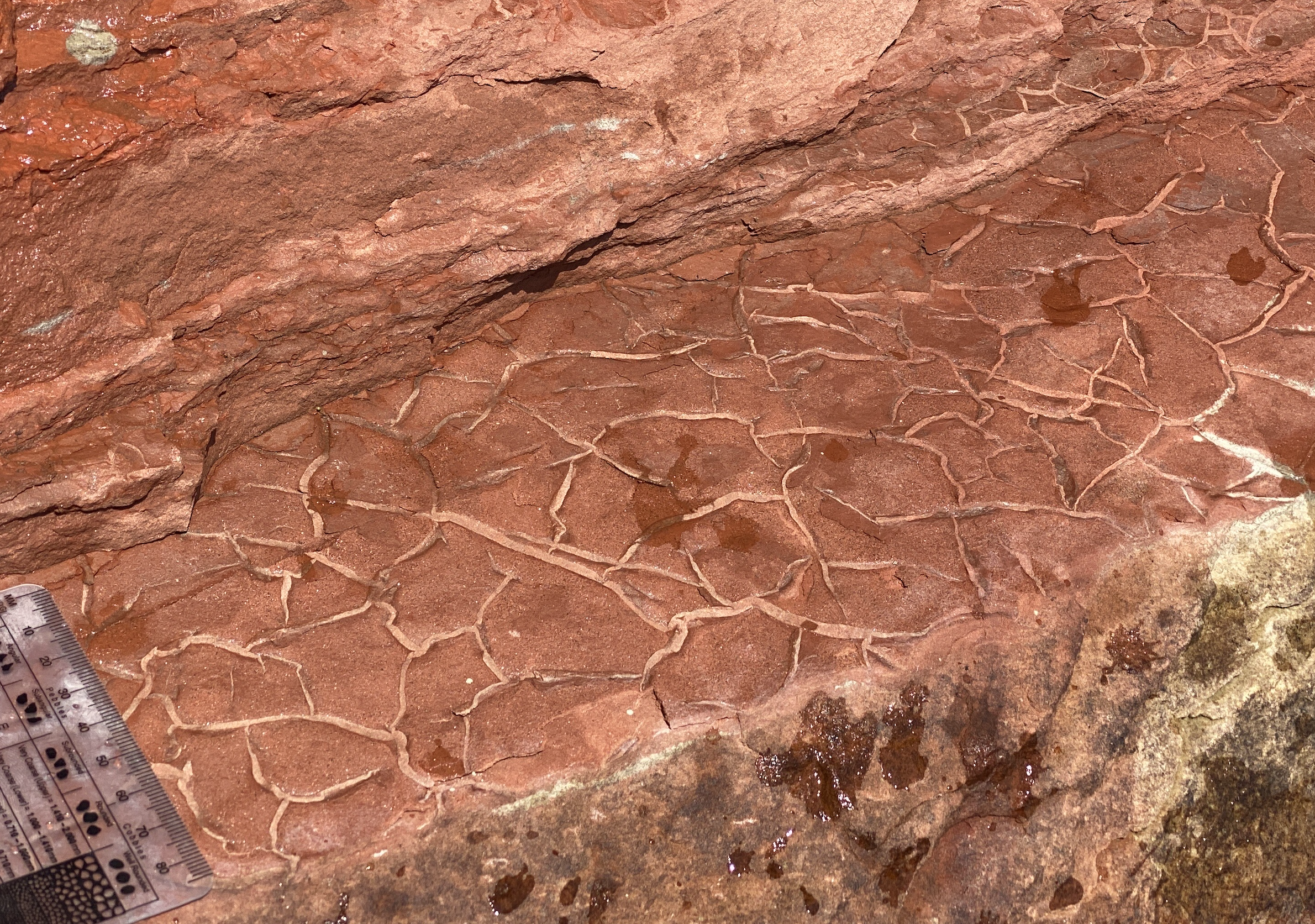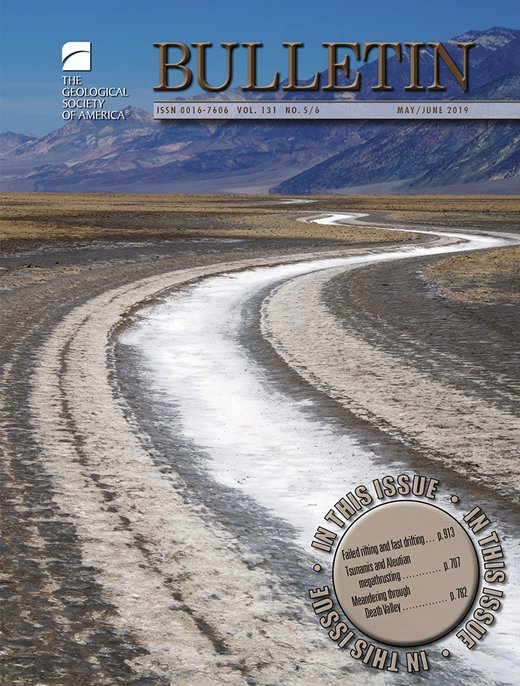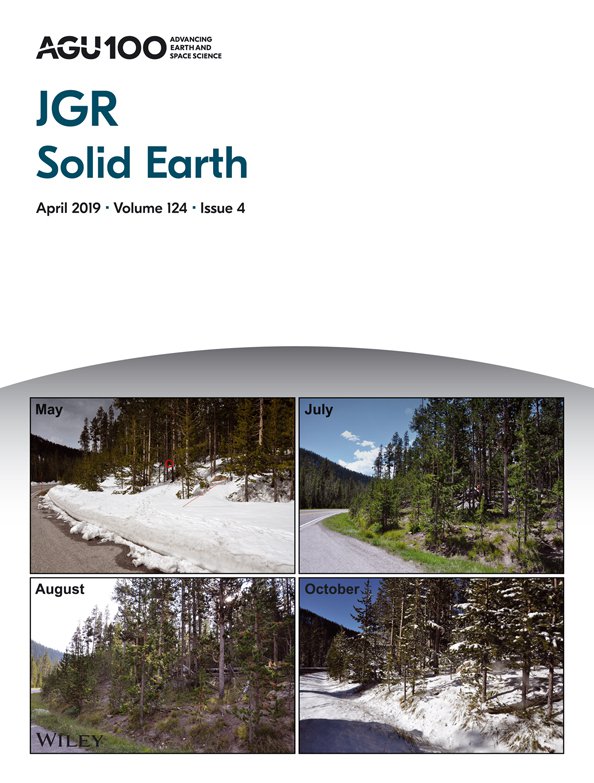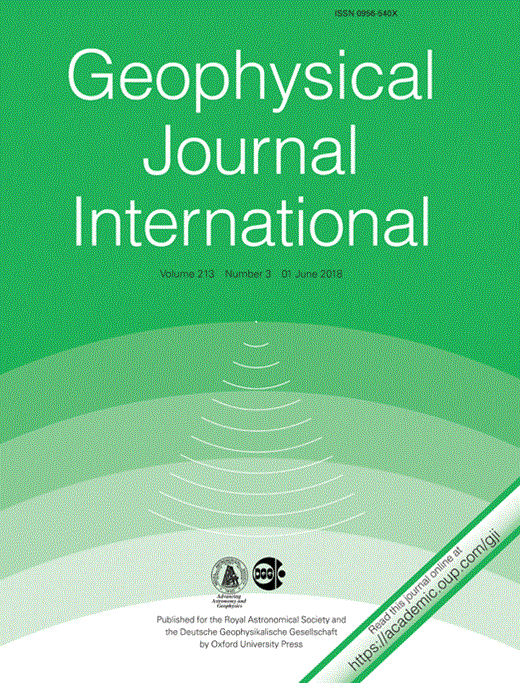Neoproterozoic basins in Australia contain superb records of changes to Earth’s climate and carbon cycle during a pivotal period of Earth history. Detailed study of these sediments is giving new insight into these changes and providing new constraints on the paleogeographic positioning and movements of the continents.
Basins that developed as Rodinia rifted apart throughout the Neoproterozoic record large changes in the biogeochemical cycling of carbon and sulfur, the waxing and waning of low-latitude ice sheets, and the progressive oxygenation of the atmosphere that facilitated the evolution of animals. We seek to test hypotheses related to this fascinating era of Earth history be conducting field campaigns in Neoproterozoic basins that pair mapping with the measurement of stratigraphic sections, observations of physical sedimentology and the generation of high resolution geochemical and geophysical data sets.
[EXPAND Carbon isotope stratigraphy as a tool for stratigraphic correlation and a window into the Neoproterozoic carbon cycle (click to expand)]
Correlating successions of sediments between basins is complicated in the Precambrian by the lack of calcified body fossils and the resulting difficulty in applying biostratigraphic correlation. Due to this paucity of biostratigraphic constraints, as well as the difficulty of locating volcanic units (that could potentially be dated with U/Pb geochronology) in passive margin and intracratonic settings, stratigraphers have turned to other tools. One of these tools that has become increasingly important is the correlation of carbon isotope data developed from limestone and dolostones. In the Neoproterozoic, there is high amplitude variability in the ratio of the stable carbon-12 and carbon-13 isotopes when compared to the preceding Mesoproterozoic Era and the subsequent Phanerozoic Eon. On geologic time-scales the primary input of carbon to the ocean and atmosphere system is from volcanism and metamorphism, while the primary outputs are the burial of organic carbon in sediment and the precipitation of carbonate sediments (e.g. CaCO3). These outputs differ in the ratios of the stable isotopes of carbon with organic carbon preferentially incorporating carbon-12 over carbon-13. Measuring the carbon isotopic ratio of either of these outputs can provide insight into changes in the relative strength of the fluxes. This stable isotope data is commonly expressed in δ13C notation wherein higher values indicates relatively more carbon-13. Carbon isotope records from Neoproterozoic carbonates are characterized by two features that are largely unique to the era: (1) prolonged periods with high δ13C values and (2) high amplitude departures to negative δ13C values. These prolonged periods of high δ13C have been interpreted as resulting from a strong link between paleogeography and the carbon cycle where a tropically-situated Rodinia supercontinent facilitated high organic carbon burial rates. These hypothesized high rates of organic carbon burial would have resulted in the sequestration of more 12C and a resulting rise in the δ13C of the dissolved inorganic carbon (DIC) pool that is reflected in the data obtained from carbonate rocks (Maloof et al., 2006; Schrag et al., 2002). Such a scenario is predicted for a low-latitude supercontinent due to the abundance of tropical continental shelves where rapid organic carbon burial could occur in a setting in which local anoxia resulted in remobilized phosphorus allowing for sustained high levels of productivity.
Using the interpretation that the departures to lower δ13C values are reflecting global shifts in the composition of the dissolved inorganic carbon (DIC) pool from which carbonate rocks derive their carbon, the patterns of isotopic change arising from the high amplitude departures to negative δ13C values have been correlated from one basin to another (e.g. Halverson et al. (2005, 2010); Macdonald et al. (2010)).

Carbonates of the Bitter Springs Formation of the Amadeus Basin, central Australia. The Amadeus Basin of central Australia contains a record of major changes to Earth’s carbon cycle ~800 million years ago.
One such sustained departure away from a prolonged period with high δ13C values is known as the Bitter Springs Stage and thought to have occurred approximately 800 million years ago (Macdonald et al., 2010). After originally being identified in the Bitter Springs Formation of the Amadeus Basin of central Australia (Hill et al., 2000), the stage has been interpreted to be recorded in successions of carbonate rocks in East Svalbard (Halverson et al., 2007; Maloof et al., 2006), NW Canada (Macdonald et al., 2010), Arctic Canada (Halverson, 2006; Jones et al., 2010), and northern Ethiopia (Alene et al., 2006).
These correlations are dependent on a primary origin for the the high-amplitude changes away and back to the typical high δ13C values of the era. The validity of such correlations in general is currently a subject of much debate that has been prompted by an argument that low values are a result of secondary diagenetic processes (Derry, 2010; Knauth and Kennedy, 2009). This challenge to the validity of Neoproterozoic carbon-isotope records as a proxy for the global inorganic carbon pool has focused on low δ13C being a result of diagenetic processes while taking high steady-state δ13C values to be a robust portion of the record. One argument for attributing these anomalies to global perturbations focuses on their occurrence on multiple continents. This argument provides some support and is potentially quite powerful if tested with additional radiometric age constraints, but at present remains a bit circular. This reality demands that chemostratigraphic records are paired with physical stratigraphy from many parallel sections so that geologically-focused arguments, without the ambiguity of global correlation, can be used to evaluate the primary nature of the excursions. In the Bitter Springs Formation, the shape of δ13C variability across the Bitter Springs Stage is tightly consistent across more than 400 km– both in uplifted sediments and those that remain at depth. Basin-scale reproducibility on such a scale is difficult to reconcile with the negative values being wholly attributable to diagenesis. Additionally, the acquisition of other types of data can be leveraged to evaluate whether the δ13C of the carbonates is a primary signal. In data from three sections spread across the basin, the δ13C of total organic carbon extracts from the carbonates shift sympathetically with the inorganic δ13C, strongly supporting the argument that the stage resulted from significant changes to the isotopic composition of DIC. Other negative δ13C excursions in the Neoproterozoic have δ13C values that dip below what is possible for a steady-state solution because the values are below the interpreted input to the ocean-atmosphere system with no flux out of the reservoir that is consistent with driving the remaining carbon to more negative δ13C values. During such excursions, the departure from positives values is not sustained. In contrast, the Bitter Springs Stage can be interpreted as a shift from one steady-state to another.
[/EXPAND]

Catherine Rose and I standing at the contact between the red glacial diamictite of the Elatina Formation and the tan post-glacial Nuccaleena cap carbonate. This surface represents the end of the Marinoan Snowball Earth event and is the type locality for the 635 million year old Cryogenian/Ediacaran boundary. (Photo credit: Adam Maloof)
[EXPAND The regolith hypothesis for changes to Neoproterozoic climate and the carbon cycle (click to expand)]
Recent work in central and south Australia that I conducted with my PhD advisor Adam Maloof, Princeton graduate student Catherine Rose and others has allowed for the pairing of records of carbonate and organic carbon isotopes from before and in-between low-latitude (Snowball Earth) glaciations. This work has revealed a large change in the dynamics of the carbon cycle when the icehouse period of the Neoproterozoic commenced. A paper we published in Science explains this change as the result of dramatic changes in Earth’s surface environment resulting from the first time Earth’s surface had been glaciated in 1.5 billion years. This work is described in this Princeton University press release.
In this work, we argue that changes in deep ocean chemistry, climate and the physical dynamics of ice sheets may be related to the glacial removal of a long-lived continental regolith. During ∼1.5 billion years without large-scale ice sheets on Earth, a thick veneer of regolith (the layer of weathered rock and soil that overlies non-weathered bedrock) would have developed on continental interiors. During the Sturtian ice age, the ice sheets that advanced into the tropics would have scoured continental interiors physically removing regolith. The regolith hypothesis presented in chapter 5 argues that the relatively thick glacial deposits of the Sturtian ice age are a result of a less stable substrate in contrast to the more stable ice sheers that could have been frozen to bedrock during the subsequent Marinoan ice age.
The exposure of bedrock by glacial removal of regolith would have had the effect of increasing the weatherability of continental interiors. On geologic time-scales, the flux of carbon into the ocean-atmosphere system is from volcanism (as well as metamorphism) while the fluxes out are through the burial of organic carbon (∼20% of the out flux) and through silicate weathering (∼80% of the out flux):
$latex dM_{\mathrm{CO}_2}/{dt}=F_{volcanic}-F_{organic}-F_{silicate}$
The silicate weathering flux occurs as carbonic acid reacts with silicate rocks producing cations and bicarbonate that are delivered to the ocean. The formation of carbonate sediments and their eventual burial and subduction provides the dominant long-term carbon sink. The magnitude of this silicate weathering flux ($latex F_{silicate}$ in the equation above) is a function both of temperature (itself a function of $latex M_{\mathrm{CO}_2} $ ) and of the “weatherability” of silicate rocks on Earth. It is the exposure of fresh silicate bedrock by glacial regolith removal that would have led to an increase in weatherability and thus a lower level of $latex \mathrm{CO}_2$ in the atmosphere as the Cryogenian period progressed.
Another aspect of the regolith hypothesis is that with glacial regolith removal would have come a shift in the locus of chemical weathering into continental interiors. As a result, there would have been an increase in the relative proportion of weathered materials from the interiors relative to continental margins. Given the significant differences between the relative amounts of iron and sulfur in the lithologies that dominate continental interiors versus those on the margins, this change could have led to a significant increase in the relative flux of iron to the ocean. In Swanson-Hysell et al., 2010, we argue that this change in the locus of chemical weathering led to changes in deep ocean chemistry that contributed to the observed changes in carbon cycle dynamics before and after the Sturtian ice age.
[/EXPAND]
Connections between Paleogeography and Neoproterozoic Global Change
Paleogeography sets the boundary conditions for many aspects of Earth system evolution. The latitudinal distribution of the continents and their configuration has significant effects on the physics of Earth’s surface through its control on ocean/atmosphere circulation and global albedo (Barron, 1981). Paleogeography can also exert powerful controls on the carbon cycle through processes such as silicate weathering and the land-area carbon cycle feedback (Walker 1981; Marshall 1988) and the enhancement of organic carbon burial on tropical continental shelves (Schrag et al., 2002; Maloof et al., 2006). Rodinia’s positioning and breakup has been hypothesized to have been a dominant control on the large-scale variations in climate and biogeochemical cycling during the Neoproterozoic Era (Hoffman et al., 1998; Hoffman, 1999; Schrag et al., 2002; Lewis et al., 2004; Donnadieu et al., 2004), that themselves are hypothesized to have played a central role in the evolution of animals (Hoffman et al1998a, Narbonne et al., 2003a, Canfield et al., 2007). These strong ties between changing continental positions and other aspects of Earth’s evolving surface environment have been one of the prime motivators for driving continued research that seeks to test late Proterozoic paleogeographic models.
[EXPAND The relative positioning between Australia and North America in the supercontinent Rodinia and paleomagnetic constraints from the Bitter Springs Formation (click to expand)]
Despite the widespread acceptance of the hypothesis of the supercontinent Rodinia, there is still vigorous debate regarding the position of its constituent cratons. A particular focal point for debate has been the relative positioning between North America (Laurentia) and Australia (which at the times was associated with East Antarctica). The fixation on their relative position exists to due to:
• History. Correlations of geological provinces between Australia and Laurentia first led to reconstructions of Rodinia.
• Importance. Both of the cratons were large continental blocks by the end of the Mesoproterozoic that have significant Grenville-age orogenic belts and Neoproterozoic rift basins. As a result, their inclusion within the supercontinent is rarely contested. Furthermore, the Neoproterozoic sedimentary basins on each continent are crucially important for interpreting paleoclimate and other aspects of Earth history through the Era.
• Clever Acronyms. The debate has been facilitated by clever acronyms and nicknames for the reconstructions.
• Growing paleomagnetic database. A burgeoning paleomagnetic database has allowed for reconstructions to be tested and modified with additional quantitative constraints that are brought to bear from time to time.
Despite years of debate, the problem is unsolved and there is still a distinct lack of constraints for Australia in the Neoproterozoic prior to the end of the Cryogenian Period. There is a particular paucity of constraints from northern Australia with a >400 Myr gap between the last Mesoproterozoic pole (∼1070 Ma) and the first Neoproterozoic pole (∼630 Ma). The work presented in chapter 4 was conducted to remedy this gap and to obtain paleomagnetic poles from during and after the Bitter Springs Stage. In the chapter, directional remanence data are presented from more than 630 paleomagnetic samples of carbonates, siltstones and basalt flows of the Bitter Springs Formation. Utilizing these data, their field context (chapter 4 and appendix A) and a suite of rock magnetic experiments, we are able to constrain the carriers and relative timing of their remanences with respect to the two subsequent orogenic events on the periphery of the basin. In doing so, I use the results of a new reliable pole from the Johnny’s Creek Member to provide strong support for a recently published hypothesis that there was relative rotation between north and south+west Australia during the end-Neoproterozoic Ediacaran Period (Li and Evans, 2011), and for the long-standing hypothesis that Australia and Laurentia were cotravelers in Rodinia until they rifted apart during the Cryogenian Period. With this new pole, we can quantitatively constrain the relative positioning of Australia and Laurentia more robustly than has previously been possible. The approach taken for this reconstruction is to pair the new Johnny’s Creek pole with time equivalents from Laurentia while at the same time aligning late Mesoproterozoic poles from Australia with the the “Keweenawan Track” of Laurentia (see this research page for more information).
The Love’s Creek Member pole is very similar to Cambrian poles from the Amadeus Basin which along with some inferences from the rock magnetic data suggest that the Love’s Creek Member direction could be a result of a Cambrian remagnetization. The timing of this potential remagnetization is consistent with the timeline of subsidence in the basin and when burial through the temperatures associated with the conversion of smectite clays to illite (a conversion associated with magnetite authigenesis) would have occurred. However, I present the possibility that the difference between the Love’s Creek Member and Johnny’s Creek Member poles of the Bitter Springs Formation is a result of large-scale true polar wander. An intriguing aspect of such an interpretation is that it yields a snug geologically consistent SWEAT-style connection between Australia and Laurentia (Fig. 4.22). In a paper currently accepted for publication in the American Journal of Science, I am also able to use a remanence held by secondary iron sulfides to constrain the history of deformation and fluid flow during the Devonian-Carboniferous Alice Springs Orogeny.
[/EXPAND]

Paleogeographic reconstructions between Australia and Laurentia. These reconstructions use the hypothesized late Proterozoic outlines of Laurentia, Australia and South China (in the missing-link reconstruction) and illustrate the range of configurations that have been proposed been the continental blocks (Brookfield (1993); Burrett and Berry (2000); Dalziel (1991); Evans (2009); Hoffman (1991); Karlstrom et al. (1999); Li et al. (2008); Li and Evans (2011); Li et al. (1995); Moores (1991); Wingate and Giddings (2000))









